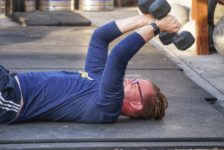
Like most things, the most accurate truth about one’s well being will come down to awareness. Without finely tuned self-awareness, it’s difficult to understand oneself with any degree of accuracy. You see, our awareness is like a muscle in and of itself. To strengthen it, it seems as though we ought to use it. After all, those with the highest levels of self-awareness have gotten to know themselves with a concoction that is one-part life experiences and one part focused attention.
Making observations with intentional focus gives the subject an opportunity to take in more useful information. This information will either meet expectations or not, and these fluctuating deviations between one’s perceived expectations and authentic reality will begin to tune one’s self-awareness. One may begin to believe that she is quite intelligent, for example, if she narrowly participates in the world around her, confirming this understanding. Accumulating more challenging experiences, however, may call this assumption into question by illustrating a more authentically true reality: “While I’m smarter than some, I now know I’m somewhere in the middle with regards to overall intelligence after spending a semester in college.”
With little experience to go on, a toddler will stumble and, not knowing if he is injured, will look up to see the reaction of his parents as a guide to determine his reality. If the parents are mortified, the child assumes he is injured and will cry. If the parents are nonchalant, the child will assume he’s OK. This child is using an inexperienced, unreliable level of awareness. With more experience falling down, expecting to be injured, and later learning that the body is fine, the child will formulate a more accurate level of awareness to determine his own reality. It’s like using a sundial to measure a sprinter’s time trial. Developing better self-awareness would be like leveling up to using a stopwatch. Both are technically faulty interpretations of the authentic running time of the sprinter, but I think we can all agree that using a stopwatch will yield a better understanding of reality than the unrefined sundial.
If your experience with your body is limited, most any discomfort will be interpreted poorly. As a result, unaware athletes often confuse soreness and even temporary acute pain as injury and so it is better to visit clinic of Kinetix Austin to sort every issues at its early stage itself.
Surely, this isn’t a call for young, beginner athletes to power through discomfort because their bodies are always lying to them. It is, however, a call to awareness. Pay attention to yourself. After all, shouldn’t we know ourselves best? Unfortunately for most, this isn’t the case.
In fact, a wonderful way to stay injury free is to explore exposures to discomfort that aren’t technically injuries. There are a number of fairly controlled environments where one can seek discomfort safely as a means to increase self-awareness and resilience to perceived injury. Remember, in nearly all cases, disconfirming information is your direct line to a new, more accurate truth. Turn on your awareness, people. You need to use it to get it.
Logan Gelbrich
@functionalcoach
8/8/17 WOD
Complete 4 roads for quality of:
10 Good Mornings
10 Hanging Leg Raises
15 Reverse Hypers
100’ Forward Sled Drag
Then, AMRAP 9
9 Ring Dips
18 Hand-to-Hand Swings (70/53)
30 Double Unders

